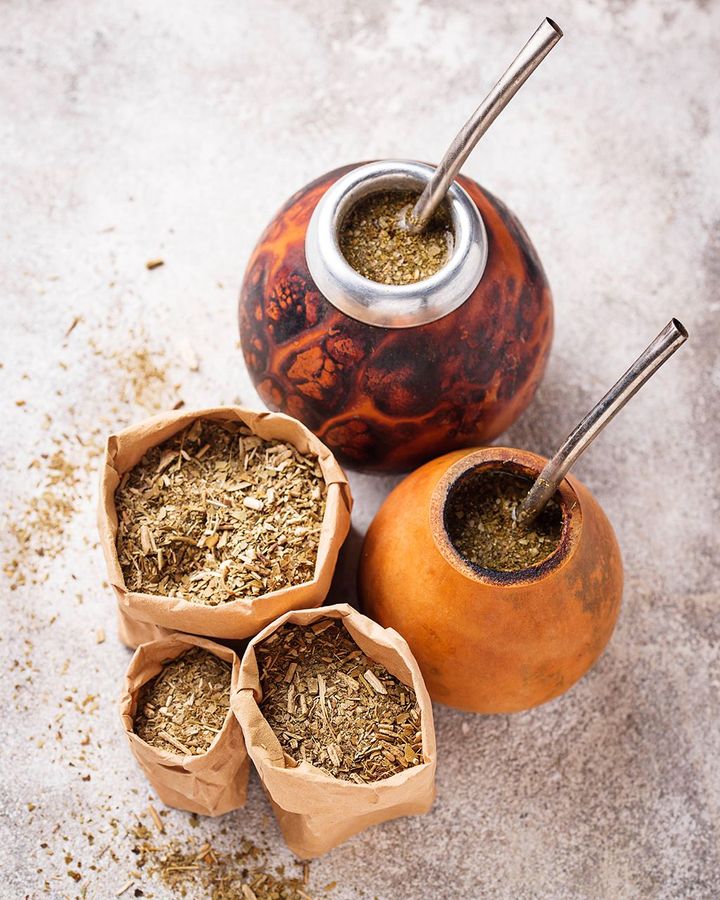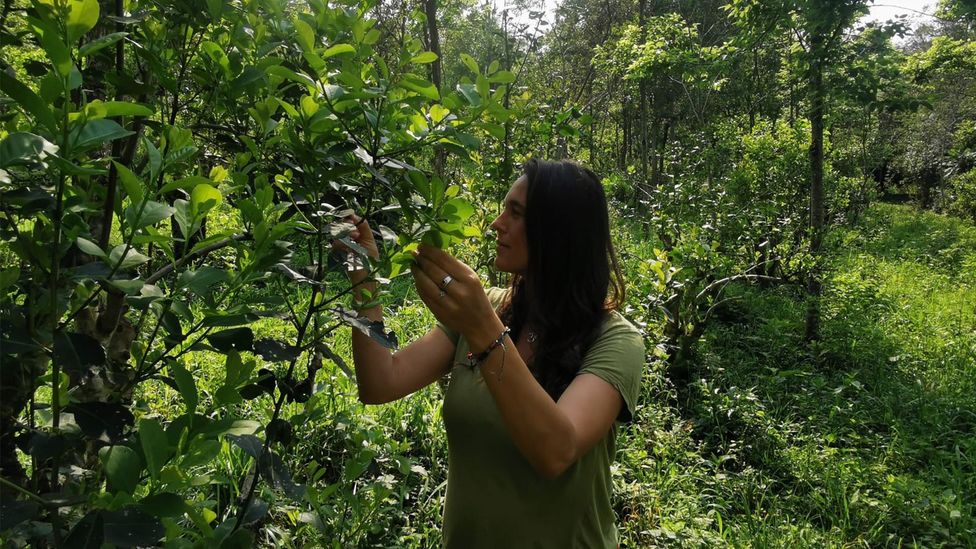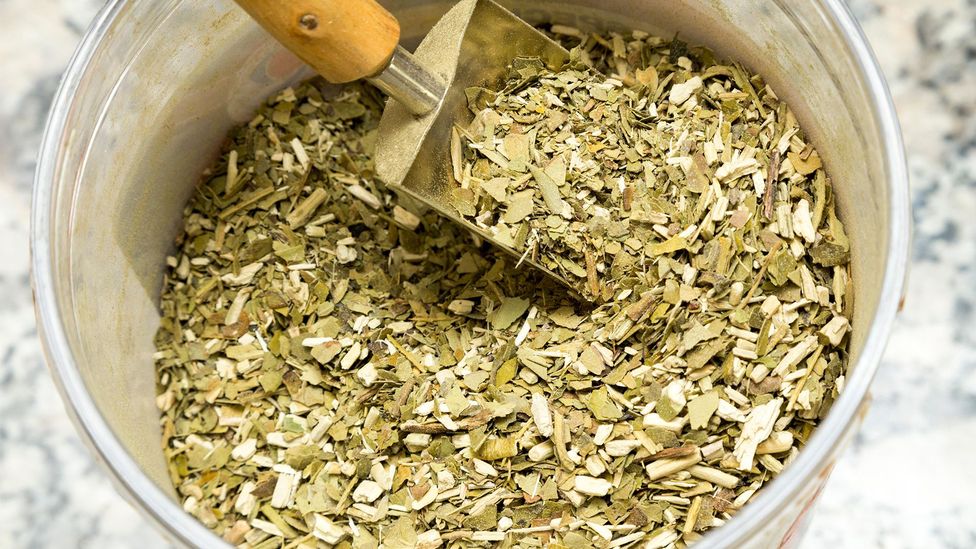It's 10:30 in the calm, wide streets of La Paternal in Buenos Aires, a neighbourhood of low-rise residential buildings, warehouses and art studios. Marcela Coll is climbing and twirling on a black aerial silk hanging from the eaves at her circus school Circodromo. Coll slides gracefully down onto the mats and heads for the thermos of hot water and a drinking vessel filled with dried yerba mate leaves, pours some water over the leaves, sips the resulting hot, light-green liquid through a metal bombilla (straw), and then pours more water over the leaves. With the thermos cradled in her elbow and drinking vessel in her hand, she watches a student pull herself up the silk.
Consumed mostly in Argentina, Uruguay, Paraguay and Brazil – as well as in Syria and Lebanon – traditional mate (pronounced MAH-tay) is a hot, bitter, caffeinated tea made by steeping the dried leaves of the yerba mate plant. The leaves are placed inside a bowl- or cup-shaped drinking vessel, also called a "mate", which can be made from a variety of materials: a dried, hollowed-out gourd called a calabaza, wood, metal, leather-covered glass or silicone.
Hot water (ideally at 75C/167F so as not to burn the leaves) is poured onto the leaves from a thermos or kettle, and the water is sipped through the metal straw. The drinker sips several times until they hear a little slurping sound called a ruidito indicating there's no liquid left in the mate, which means it's time to pour on more water and pass the vessel on to another person. Some add lemon or orange peel, mint or verbena, while others, more controversially, add sugar, honey, coffee powder or even whiskey.
But in the last couple of decades, mate started experiencing a boom outside of South America. Karla Johan, a mate sommelier from Misiones, Argentina, attributes this partly to football players from Argentina and Uruguay bringing the habit to Europe, where they moved to play for local teams. In fact, one might say that mate is the "beverage of champions". When Argentina's national football team travelled to Qatar in December 2022 to play – and win – the World Cup, they carried 240 kg of yerba mate with them.

Mate in Argentina is all about sharing (Credit: Yuliya Furman/Alamy)
"Now with [Lionel] Messi living in Miami, he's become a great ambassador of mate, like a living showcase of mate consumption," Johan added. (Fun fact: Messi drinks mate from Uruguay, not Argentina.)
Global messaging platform WhatsApp recently introduced a mate emoji, which points to mate's growing popularity as people aim for a healthier lifestyle in the post-pandemic era. That's because mate, said Johan, contains a higher level of antioxidants than green tea or red wine, and a powerful combination of vitamins (A, B, B1, B2, C), 15 amino acids and minerals (iron, magnesium, potassium) from the clay soil where it grows. Perhaps it's these qualities that also make mate a go-to hangover cure for Argentines.
Nevertheless, in Argentina, mate is ubiquitous, a faithful companion for matters great and small. Yet, unlike coffee or tea, it is not consumed in cafes: it's what you have at home and at work, in the park and on the train, during class or at the gym.
"I have memories of deciding big things while having mate, like Circodromo. During the huge creative moments in my life, mate is always a part of it. And when I wake up in the morning, the first thing I say is matecito, matecito [a diminutive form of "mate"]. But mate is not only to wake you up; it's also more of a social thing, for sharing," said Coll.
The tradition of ronda de mate, or passing around the mate, and the consumption of mate in general, originated with the Indigenous Guaraní people, a group traced back to roughly 500CE who lived (and still live) in what is now southern Brazil, northeast Argentina and Paraguay. The Guaraní believed in the spiritual powers of the yerba mate plant and that "sharing mate with each other was a way of uniting their spirits," said Diego Morlachetti, tea master and co-director of the yerba mate program at Universidad Abierta Intramericana.
A more sustainable yerba mate
According to producer Marina Parra, who tends an organic farm in Misiones, "Mate is part of our ancestral identity, but unfortunately, the use of herbicides and fertilisers on yerba mate plantations has spread alarmingly. The soil has become eroded and impoverished." Parra and a growing number of other yerba mate producers are championing sustainable crop management to yield more climate change-resistant plants, and they have implemented changes like incorporating native trees for shade, insect pollinators, cover crops and compost and manure.
For the Guaraní, the yerba mate plant was also a rich source of diverse nutrients and served as an appetite suppressant, both properties that helped them to survive long-distance treks. They used mate to dye fabrics, to treat liver problems and even as part of their religious rites, in which they purged themselves to purify their spirit. In fact, it was this purging ritual that drew the attention of Jesuit missionaries who arrived from Spain in the mid-1500s.
"The Jesuits initially forbade the drinking of mate when they saw the Guaraní people sometimes consuming too much and vomiting. But then the Jesuits realised they could commercialise yerba mate, so they started plantations and sold yerba mate on both sides of the Rio de la Plata [which now includes Buenos Aires city and the western coast of Uruguay] and to Bolivia, Peru and southern Chile," explained Johan.
Today, every country of mate fanatics has its own preferred blend. In Argentina, leaves are naturally aged for up to two years and contain some palo, or small pieces of twigs from the yerba mate plant. Uruguay's blend combines aged leaves with powdered leaves and consists of a very minimal amount of palo. This blend is known for its longer lasting flavour.

Parra and a growing number of other yerba mate producers are championing sustainable crop management (Credit: Andres Alvarez)
Brazil's yerba mate is immediately recognisable for its neon green, powdery appearance, as the leaves are not aged and are finely ground, resulting in a soft, slightly sweet flavour.
Paraguay's humid, tropical climate is more conducive to drinking mate with cold water, called tereré, so their yerba mate blend includes dried herbs and fruits; the most famous blend is a combination of mint and another herb known as boldo.
Although seasoned mate drinkers are faithful to its more traditional hot tea form, different brands have found other uses for the plant: mate-infused craft gin (Apóstoles, Kalmar) and craft beer (Laska), mate-flavoured kombucha (Aloja) and powdered yerba mate in pastries and even in beauty creams.
And it's no surprise that three of the most popular foods in Argentina have also been touched by the yerba mate wand: ice cream made at Helados Garavano in the Argentine province of Corrientes, alfajores (traditional cookies) and pizza – which is topped with mate-flavoured mozzarella, the invention of pizzeria Dolce Vita in Apóstoles, Misiones.

Three of the most popular foods in Argentina have started to incorporate yerba mate (Credit: Federico Julien/Alamy)
For the past few decades, brands like Guayakí in the US and Club-Mate in Europe have offered up mate as a healthy, fruit-flavoured, sparkling beverage or an energy drink, packaged in cans and bottles. Now, several Argentine brands – like Yará (from yerba mate producer Origen) and Yací – are selling this interpretation of mate in their own backyard.
Only time will tell whether this catches on in Argentina and nearby nations who share the mate-drinking tradition. But Morlachetti says that while the ready-to-drink version of mate works for the US market, "in Argentina, mate has always been about the ritual. Mate is not practical – you need the mate itself, the bombilla, the yerba mate leaves, a thermos with hot water. But that is the beauty of it. Mate in Argentina is all about sharing."
BBC.com's World's Table "smashes the kitchen ceiling" by changing the way the world thinks about food, through the past, present and future.
---
Join more than three million BBC Travel fans by liking us on Facebook, or follow us on Twitter and Instagram.
If you liked this story, sign up for The Essential List newsletter – a handpicked selection of features, videos and can't-miss news delivered to your inbox every Friday.
Bagikan Berita Ini














0 Response to "Yerba mate: South America's 'beverage of champions' - BBC.com"
Post a Comment